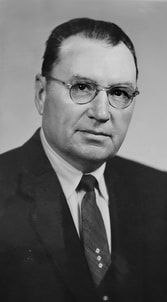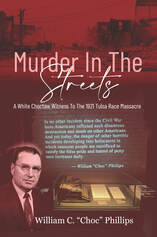Murder In The Streets
A White Choctaw Witness To The 1921 Tulsa Race Massacre
|
Paperback
152 pages • 6 x 9 ISBN 9781681792255 Suggested Retail Price $17.95 |
By William C. “Choc” Phillips
The 1921 Tulsa Race Massacre occurred over two days, May 30 and June 1, 1921, when a white mob destroyed the African American section of Tulsa, Okla., known as the Greenwood District. As a result, more than 1,250 homes and businesses were destroyed, thirty-five square blocks of Tulsa leveled, and hundreds of innocent people were injured or dead. There have been numerous book and news articles written about the 1921 Tulsa Race Massacre, but most of the first-person accounts were given by African Americans. However, William C. “Choc” Phillips was part white and part Native American and an eyewitness to one of the most violent episodes in the history of the United States. A teenager and high school student at the time of the 1921 Tulsa Race Massacre, Phillips was present when the violence ignited in front of the Tulsa Courthouse and eyewitness to the destruction that followed. Phillips and a group of high school friends traveled the streets of Tulsa throughout the night of May 30 and during the day on June 1. At times they were trying to get a better view of what was happening and at times trying to escape the violence. They saw people murdered, buildings torched, and people treated as less than human. The incident left a lasting impression on Phillips, and over the years, he researched and wrote his account of the 1921 Tulsa Race Massacre. He read most of the news accounts of the time and, in later years, interviewed other eyewitnesses of the devastation. Phillips attempted to make sense of what had happened and give a balanced report of the event. Phillips was never able to get his manuscript published when it was completed in the 1980s. Thus, despite the death and destruction, after the passing of sixty years, the 1921 Tulsa Race Massacre was not a well-known event on a national level. It was as if people wanted to pretend the violence never happened or, at the very least, forget about it. In 2021 Greenwood Rising opened in Tulsa to commemorate the 100th anniversary of the 1921 Tulsa Race Massacre and, more importantly, to educate the public. Officials with Greenwood Rising thought William C. “Choc” Phillips’ account was important enough to create a display that showcases the original manuscript and the typewriter that produced it. |
About the Author

William C. “Choc” Phillips was born Dec. 1, 1901, in Greer County, Okla., and moved with his family to Tulsa in 1918. His lineage?
In 1921 he was attending high school in Tulsa and working as an usher at the Royal Theatre. On May 31, 1921, Phillips was an eyewitness to violence and destruction in Tulsa that became known as the 1921 Tulsa Race Massacre. It was an incident that would be embedded in his memories for his entire life.
Following high school, Phillips pursued a career in show business as a vaudeville performer and show manager. In 1938 he was a founding member of the Society for the Preservation and Encouragement of Barber Shop Quartet Singing in America (SPEBSQSA), which would later be known as the Barbershop Quartet Society. Phillips also joined the Tulsa Police Department in 1938 as a member of their barbershop singing quartet that toured the United States promoting Tulsa.
During World War II, Phillips served in the U.S. Coast Guard before returning to his duties with Tulsa Police Department. During his police career, he was the president of the Fraternal Order of Police, formed the School Crossing Guard Program for the Tulsa public school system, and helped develop the Tulsa Police Retirement program that became a model for departments nationwide.
After retiring from the Tulsa Police Department, he became a cattle rancher in Leonard, Okla. In 1988 Phillips decided to put his memories and research of the 1921 Tulsa Race Massacre on paper and called on his niece, Stephanie Maggio, to assist him with the project. He continued ranching until his death on Dec. 10, 1991.
He was married to Annalee Elaine, his sweetheart whom he met while singing with his barbershop quartet group and the Tulsa Sweet Adelines, of which Elaine was a member. They had two children, Larry and Susan.
